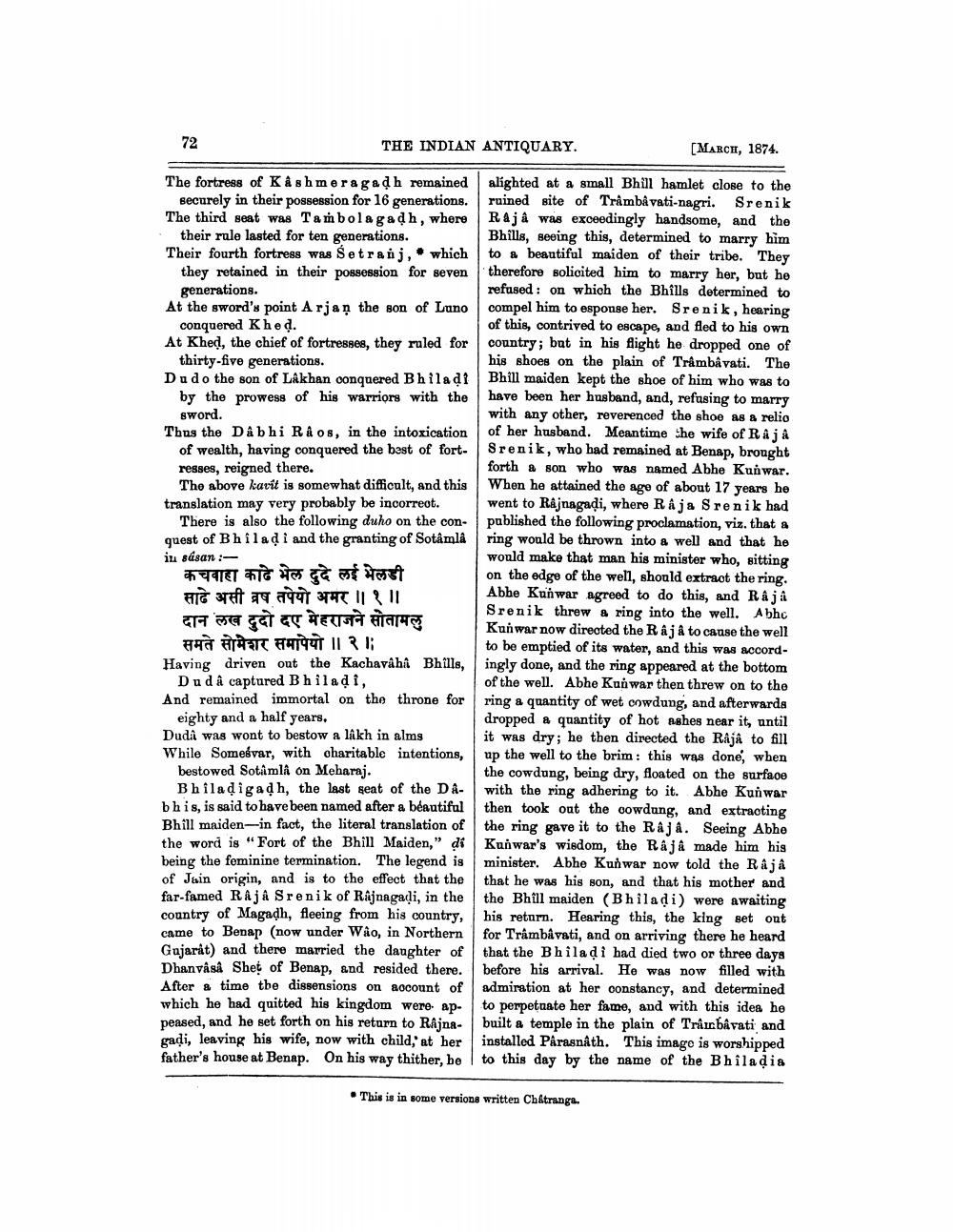________________
72
THE INDIAN ANTIQUARY.
[MARCH, 1874.
The fortress of Kashmeragadh remained
securely in their possession for 16 generations. The third seat was Tambolagadh, where
their rule lasted for ten generations. Their fourth fortress was Setranj, which
they retained in their possession for seven
generations. At the sword's point Arjan the son of Lano
conquered Khed. At Khed, the chief of fortresses, they ruled for
thirty-five generations. Du do the son of Lakhan conquered Bhiladi
by the prowess of his warriors with the sword. Thus the Dabhi Raos, in the intoxication
of wealth, having conquered the best of fort. resses, reigned there.
The above kavit is somewhat difficult, and this translation may very probably be incorreot.
There is also the following duho on the con. guest of Bhilad i and the granting of Sotâmlâ in sásan :
कचवाहा काढे भेल दुदे लई भेलडी HIC tot as 90 THT 118 11 दान लख दुदो दए मेहराजने सोतामलु
समते सोमेशर समापेयो ॥ २॥ Having driven out the Kachavahi Bhills,
Dud â captured Bhiladi, And remained immortal on the throne for
eighty and a half years. Duda was wont to bestow a lakh in alms While Somešvar, with charitable intentions,
bestowed Sotamla on Meharaj.
Bhiladigadh, the last seat of the DA bhis, is said to have been named after a beautiful Bhill maiden-in fact, the literal translation of the word is "Fort of the Bhill Maiden," di being the feminine termination. The legend is of Jain origin, and is to the effect that the far-famed RAJA Srenik of Rajnagadi, in the country of Magadh, fleeing from his country, came to Benap (now under Wao, in Northern Gujarat) and there married the daughter of Dhanváså Shet of Benap, and resided there. After a time the dissensions on account of which he had quitted his kingdom were, ap- peased, and he set forth on his return to Rajna- gadi, leaving his wife, now with child,' at her father's house at Benap. On his way thither, be
alighted at a small Bhill hamlet close to the ruined site of Trimbê vati-nagri. Srenik RAj was exceedingly handsome, and the Bhills, seeing this, determined to marry him to a beautiful maiden of their tribe. They therefore solicited him to marry her, but he refused : on which the Bhills determined to compel him to esponse her. Srenik, hearing of this, contrived to escape, and fled to his own country; but in his flight he dropped one of his shoes on the plain of Trâmbâvati. The Bhill maiden kept the shoe of him who was to have been her husband, and, refusing to marry with any other, reverenced the shoe as a relio of her husband. Meantime she wife of Raj A Srenik, who had remained at Benap, brought forth a son who was named Abhe Kunwar. When he attained the age of about 17 years be went to Rajnagadi, where Raja Srenik had published the following proclamation, viz. that a ring would be thrown into a well and that he would make that man his minister who, sitting on the edge of the well, should extract the ring. Abbe Kunwar agreed to do this, and Raja Srenik threw & ring into the well. Abhc Kunwar now directed the Raj A to cause the well to be emptied of its water, and this was accordingly done, and the ring appeared at the bottom of the well. Abhe Kunwar then threw on to the ring a quantity of wet cowdung, and afterwards dropped a quantity of hot ashes near it, until it was dry; he then directed the Råjå to fill up the well to the brim: this was done, when the cowdung, being dry, floated on the surface with the ring adhering to it. Abhe Kunwar then took out the cowdung, and extracting the ring gave it to the Raja. Seeing Abhe Kunwar's wisdom, the RajA made him his minister. Abhe Kunwar now told the Raja that he was his son, and that his mother and the Bhill maiden (Bhiladi) were awaiting his return. Hearing this, the king set out for Trambavati, and on arriving there he heard that the Bhiladi had died two or three days before his arrival. He was now filled with admiration at her constancy, and determined to perpetuate her fame, and with this idea he built a temple in the plain of Trichavati and installed Párasnáth. This image is worshipped to this day by the name of the Bhiladia
• This is in some versions written Chatranga.




